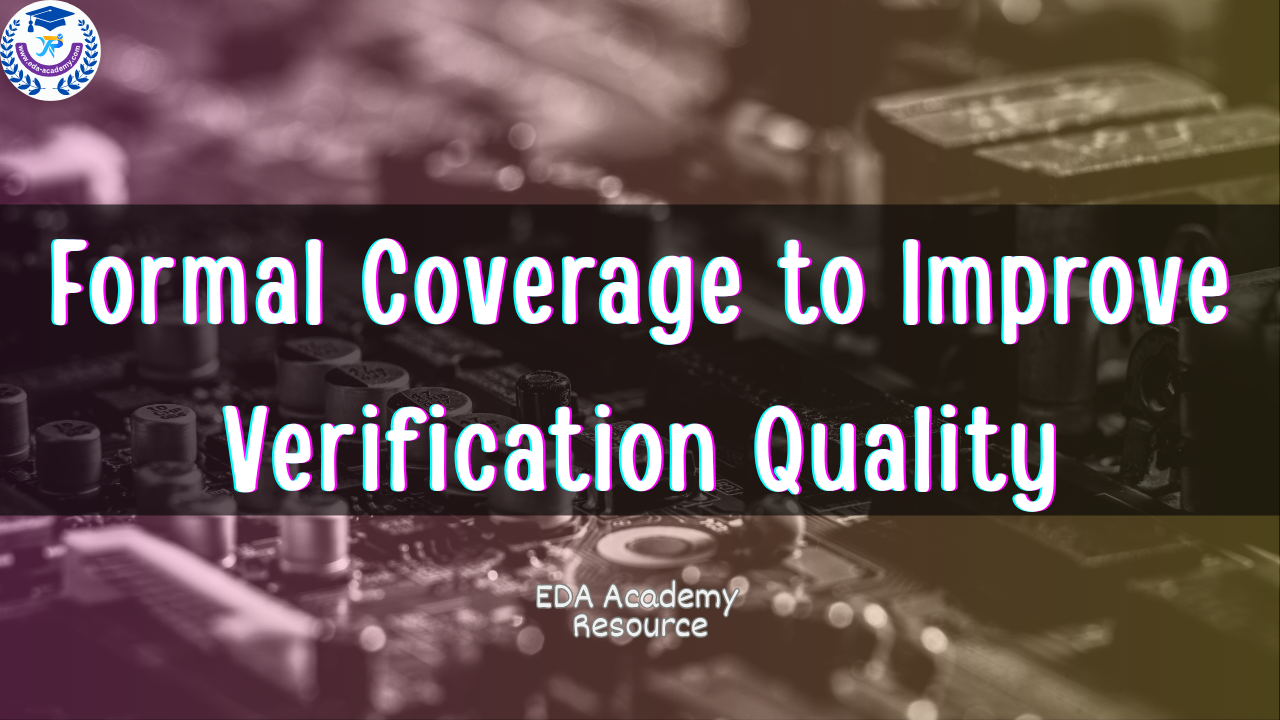Resource:
Formal Coverage to Improve Verification Quality (English)
Formal coverage quantifies the completeness of formal proofs by analyzing which parts of the design are exercised, constrained, and verified. It includes proof coverage, vacuity detection, bounded-depth analysis, and fault-based mutation response. These metrics provide insight into specification completeness and detection robustness. Formal observability and controllability identify unreachable or untestable logic. By integrating mutation techniques and dynamic coverage strategies, formal coverage supports efficient bug-hunting and systematic refinement of property sets. It also enables sign-off strategies that combine full proofs with coverage-driven confidence. This framework enhances traceability and provides a structured path toward measurable verification closure.
Purchase
Our course syllabus is regularly updated to reflect the latest advancements and best practices in the field. For individually purchased courses or resources with lifetime access, students can always access the content and receive updates for free. For members, all member-free courses and resources — including future updates — are accessible during the active subscription period. This ensures that both lifetime purchasers and active members can benefit from the most relevant and up-to-date content.
Created by EDA Academy
English
Last updated July 2025

Resource: Formal Coverage to Improve Verification Quality (English)
USD $199.9
-60%Today
$79.9
One-time Purchase
& Lifetime Access
What you will get:
1.2 Hours of Immersive, High-Quality Video Lessons
Professionally produced and delivered by our expert team, covering core concepts and practical demonstrations, with step-by-step explanations and real-life examples to help you efficiently absorb knowledge and apply it immediately in a short time.
Certificate of completion
Upon successful completion of the course, you will receive an official certificate issued by EDA Academy, adding value to your resume and career development.
Access on mobile and computer
The course can be viewed anytime on mobile phones, tablets, and computers, allowing you to learn easily whether at the office, at home, or on the go.
Ongoing support from EDA Academy
After the course ends, you will continue to receive ongoing support from our team to help you consolidate knowledge and solve practical problems.
Further learning plan
Provides you with follow-up learning paths and recommended resources, enabling you to continue improving your skills and expanding your career development based on what you have learned.
Resource Catalogue
Description
Formal coverage enables structured insight into the reach and effectiveness of formal proofs. A property might pass verification, but without knowing what portions of the design were analyzed and under what constraints, the result remains ambiguous. Formal coverage addresses this gap by exposing what has been proven, what remains untested, and where assumptions weaken observability. This includes both structural and semantic elements—unreachable logic, untriggered assertions, and unspecified behavior paths. Formal coverage enables refinement actions based on data, such as adding properties for uncovered blocks or revising redundant constraints.
Several coverage metric types are used to build an accurate model of analysis completeness. Proof coverage identifies which parts of the state space are included in successful proofs. Vacuity detection highlights cases where properties are trivially true, indicating missed design intent or weak assumptions. Bounded-depth analysis measures how far into the state space a proof engine explored before terminating. Mutation-based coverage introduces controlled errors to determine if existing properties detect the deviation. These techniques together measure both the breadth and depth of verification and help validate the resilience of the property set against design faults.
Observability and controllability analysis further strengthen coverage interpretation. Observability ensures that a signal’s effect can propagate to a property or monitor, while controllability checks if logic can be activated from legal input sequences. These concepts originate from testability analysis but are adapted for formal flows. When combined with specification-driven coverage models, they help detect unreachable design logic, ineffective properties, and redundant formal constraints. Formal-aware coverage maps symbolic paths to high-level design goals, enabling meaningful insights into both the specification and implementation.
Formal coverage frameworks often use symbolic reachability models to determine which logic cones are included in active proofs. These are not simple toggle maps but specification-aware paths. Coverage gaps may result from weak assumptions, unconnected logic, or over-constrained inputs. Metrics must be read within context—proof convergence with low coverage may indicate strong assumptions rather than robust results. Actionable decisions from coverage feedback include refining properties, generalizing overly specific assertions, and replacing vacuous checks with behaviorally complete ones.
Coverage-driven sign-off strategies combine traditional full-prove efforts with measured formal completeness. When full convergence is infeasible, teams rely on the combination of proof metrics, coverage anomalies, and bug-hunting outcomes. Mutation-guided techniques support exploration of deep, rarely exercised logic by injecting controlled design faults. If a mutation is undetected, it reveals a verification gap. If it is detected by multiple properties, it helps rank property strength and coverage overlap. These techniques help formal teams build scalable, maintainable flows that deliver measurable confidence and robust design closure.
We HATE spam. Your email address is 100% secure
The document will be emailed to you. Please check your Spam folder if it doesn’t appear in your inbox.
We HATE spam. Your email address is 100% secure
